1974 French Grand Prix race report
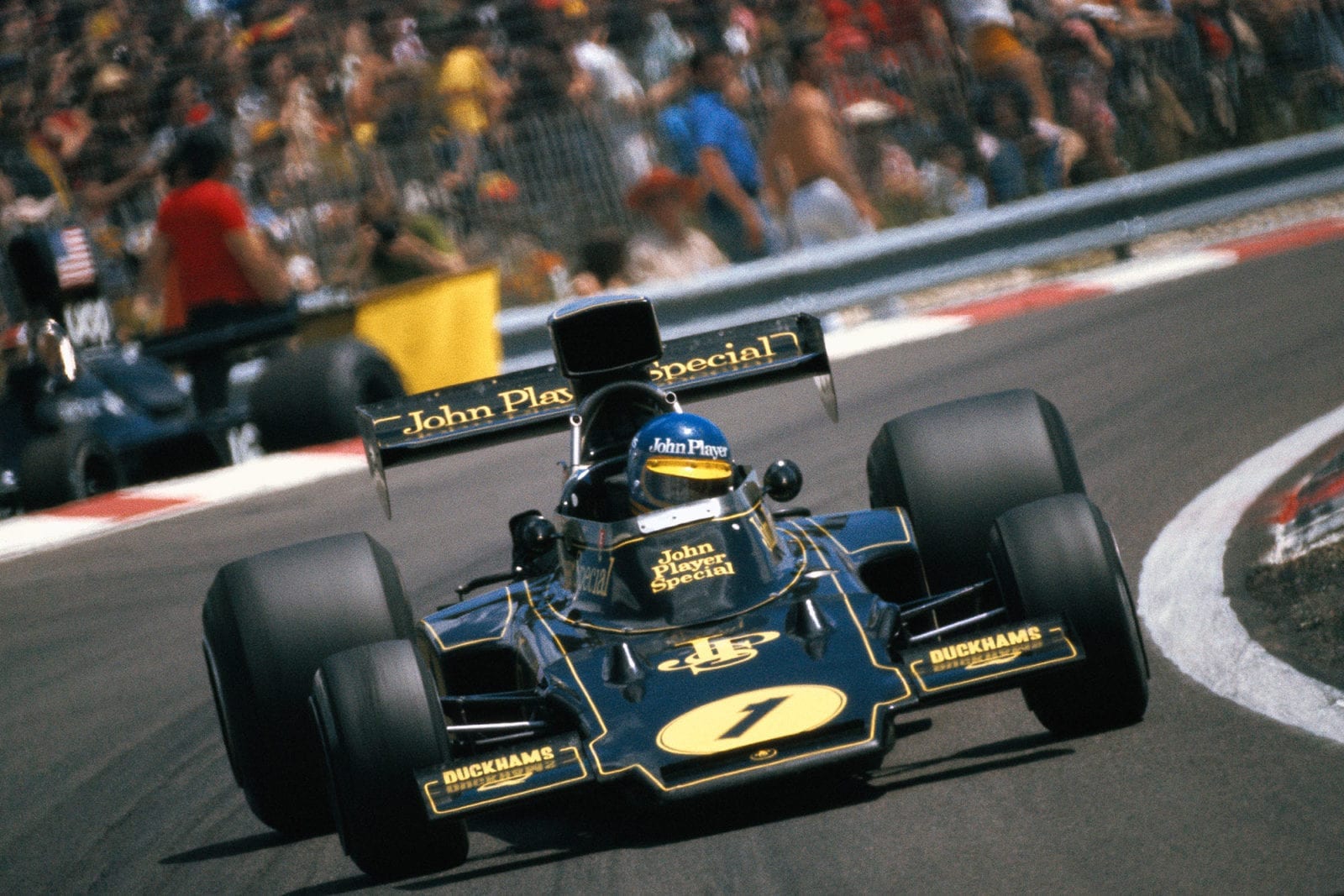
Ronnie Peterson secured Lotus' 2nd 1974 win at Paul Ricard
Motorsport Images
Minuscule
Dijon-Prenois, July 7th: Naturally enough, in their own Grand Prix, there were more French drivers having a dabble in Formula One than ever before. In addition to the established French team members, Depailler (Tyrrell), Beltoise, Pescarolo and Migault (BRM), and Jarier (UOP-Shadow), there were entries for Jose Dohlem in the Surtees team, taking the place of Carlos Pace, J-P. Jabouille in the second Williams car, Gerard Larrousse in the Italian Finotto team, and Jacques Lafitte in the Token, though the last named did not materialise. Apart from Pace being in a spare works Brabham, run under the Hexagon banner, everything was more or less in order and as before. Team Lotus had made the decision to use their old Lotus 72 cars as the first-string team cars, and to relegate the new Lotus 76 cars to the role of development vehicles for the rest of this season. The bally-hoo with which the Lotus 76 was introduced at the beginning of the year as the John Player Special has turned out to be the non-event of the winter, but everyone has a had turn now and then and the Lotus 76 looks like being Colin Chapman’s worst effort so far. The old Lotus 30 and Lotus 40 sports cars were not exactly high spots in the Lotus story, but the 25, 49 and 72 have been so fantastic that they more than make up for the failures. The 76 is not written-off and some of its features, notably the rear suspension, have come up to scratch and will be retained in the design-book at Hethel. It was just unfortunate that John Players went to such vast expense and trouble to introduce the 76 before it was ready. The Type 72 in its 1974 form is still one of the best-looking Grand Prix cars on the circuits today, and as usual Peterson was all set to do his utmost with 72/R8, while Ickx was not saying much about 72/R5. As 1T the team had JPS110 for Peterson to test, this normally being Ickx’s car, but the pedals and so on had been altered so that the Swede could drive it, as JPS/9 was undergoing sorne major alterations back at the factory. The two Type 72 cars had been fitted with new front wishbones giving a slightly wider track, a little over an inch on each side. In the Tyrrell team all was normal, with Scheckter in 007/1 and Depailler in 007/2, while last year’s car 006/2, which Tom Wheatcroft is waiting to put in the Donington Racing Car Museum, was standing by on a trailer for emergency purposes. The Texaco-Marlboro-sponsored part of the McLaren team were using the new inclined inlet trumpet layout on the cars of Hulme and Fittipaldi, they both sharing the same spare car, while Hailwood had two Yardley-sponsored cars to himself. The Brahham team were unchanged from previous races, and had their 10-in. diameter “cotton-reel” rear wheels with them to try the latest Goodyear experiments, Reutemann having BT44/1 and BT44/3, while von Opel was in BT44/2, but wondering if he was ever going to make it as a Grand Prix driver. The two works March cars were driven as usual by Stuck and Brambilla, while Regazzoni and Lauda had the works Ferraris, 014 and 012, respectively, with 011 as a spare. In the BRM team peace had been reclaimed by modifying the cockpit of the original P201 so that Pescarolo could get into it, this necessitating new fuel tanks in the cockpit sides, with the access holes in the monocoque being moved from within the cockpit to underneath. All this work meant that the car was a bit delayed and it arrived after practice had begun. Beltoise was in P201/02 and Migault was back in P160/10, that Pescarolo had driven briefly at Zandvoort. The Shadow team were in good form, with Pryce and Jarier in their usual cars, with the spare car with Jarier’s number on it, while Team Surtees had completely rebuilt TS16/02 into the new form as first seen at Zandvoort, with the water radiator across the back under the aerofoil and the curved monocoque sides without the flat extensions on the top, while the new nose cowling devoid of openings was fitted. This rebuilt car was for Jochen Mass and TS16/05, the Zandvoort car, was being entrusted to Jose Dohlem, from the Surtees Formula 2 team, the dispute with Carlos Pace having ended in a separation. As mentioned Jabouille joined the Williams team, alongside Merzario, and Pace joined the Hexagon team alongside Watson, the works Brabham BT42/3 having some brown stripes on it to distinguish it from the actual works team. Schuppan was in the 1974 Ensign, Kinnunen in his ex-works Surtees TS/16, Hunt had both the Hesketh cars at his disposal and Hill and Edwards had their usual Embassy-sponsored Lola cars, with a spare one in the background. All told there were thirty drivers in the pits ready to start practice, and only the fastest 22 were going to be accepted on the starting grid, leaving eight as spectators.
Qualifying
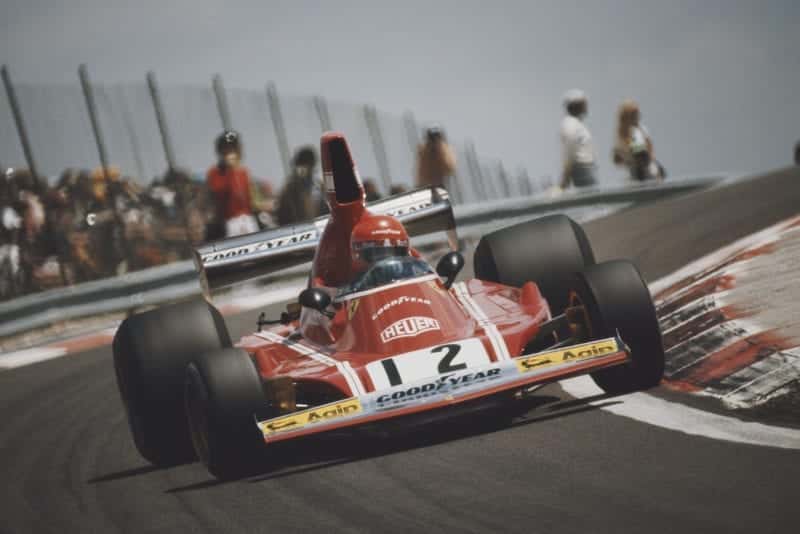
Niki Lauda took pole for Ferrari in France
Motorsport Images
When practice began on Friday morning the day was superb, with not a cloud in the sky, and apart from waiting to see whether Lauda or Peterson was going to set the pace, and which of the other regular runners was going to be up there with them, much interest centred on the “new-boys” to see who was going to make the grade and who was going to be left out of things. A few people were interested to see whether Carlos Pace was going to prove what was wrong with the Surtees team, now that he was in a Brabham, but even before he started practice his team manager was explaining how Pace had been home to Brazil and had caught a bug and was not feeling too bright. Whether it was a Brazilian bug, or a “flea in the ear” that he caught as he left Team Surtees, was not clear, but he never got beyond being amongst the tail-enders and non-qualifiers. In the BRM camp hopes were pinned on Beltoise who had the latest engine in P201/02, this having new cylinder heads with a wider angle between the inlet and exhaust valves.
It did not take long for the pattern to be set, with lap times of under one minute being the aim, but surprisingly it was Fittipaldi who was fastest with 59.20 sec., closely followed by Depailler with 59.43 sec. It seemed hard to believe that we were at a Grand Prix. With lap times of less than a minute, it seemed more like USA oval race, and the circuit called a for so little ability that everyone and anyone was within hundredths of a second of each other. Shortly before things came to a halt for the lunch break, by which time many drivers had put in 50 laps, Depailler did not come round. He had got off line in Tyrrell 007/2, and was holding it in a full-lock slide with the power hard on, trying to stop it spinning, when the rear wheels suddenly found grip and shot the car across the track and into the Armco, wrecking the right front corner and creasing the monocoque. The stocky little Frenchman said in all honesty that had he let it spin off into the gravel there would have been no damage done, but he tried to bring it straight with the power, which proved to be an expensive mistake. The result was that Tom Wheatcroft’s museum piece was unloaded from the trailer and made ready for the afternoon practice, as 007/2 was beyond immediate repair. It had been estimated that everyone would be lapping in under a minute, with the faster drivers down around 55 or 56 sec., but it was not to be so, only Fittipaldi and Depailler breaking the minute in the first session. The excellent weather continued during the afternoon and as everyone got into the swing of things more drivers joined the “under 1 minute” clan, but there were no signs of the 55-sec. laps that had been talked about. Depailler went out in the spare Tyrrell car, but it was nothing like as quick as the one he crashed, and he was unable to break the 1-rnin. barrier, and his team-mate Scheckter was taking a long time to get into the rhythm of sub-one-minute laps, even after more than 80 laps of practice. Fittipaldi was still going well, and briefly tried the experimental McLaren rear aerofoil that is mounted extremely low, below the normal height, so that it can take advantage of exceeding the 1-metre rearwards limit from the axle centre line, but it did not seem to offer much advantage. Stuck came walking back to the pits, having left his March out on the circuit with gearbox trouble, and he then went out in Brambilla’s car. Though he was quicker than in his own car, he was not among the top runners, and was not even as quick as his swarthy Italian team-mate, the fire seeming to have gone out of the young German’s driving after crashing so spectacularly at Monaco and then having another accident at Zandvoort. The new BRM engine was not performing well at the top end of the rev-range so preparations were made to replace it with a normal unit, and Pescarolo just managed to get in two timed laps when his modified P201 eventually arrived. Due to the wrangles of the Formula One Constructors Association and their “closed shop” methods, Schuppan was prevented from practising the Ensign and Kinnunen his Finnish-sponsored Surtees. There were now seven drivers in the “under 60 second” club, these being Lauda, who was fastest with 58.91 sec., Peterson, Fittipaldi, Reutemann, Regazzoni, Jarier and Hunt, though the results sheets looked a bit like a British hill climb, and not like the oldest Grand Prix in history.
On Saturday morning the lovely blue sky had disappeared and everything was grey and overcast, though it was still warm. In fact it was about ideal for fast times and when it all started up again in the morning session, Reutemann was trying the 10-in. diameter wheels on his Brabham, Peterson was having a brief go in the Lotus 76, while Ickx was waiting for his car to be finished off. It was not long before a cloud of smoke heralded the end of Merzario’s practice as his engine blew up and he coasted to rest opposite the pits. It was proving an expensive trip for Frank Williams, as Jabouille’s engine had broken the day before. Then another cloud of smoke saw Migault returning to the pits with oil everywhere except in the engine, and there was a pause in practice while Merzario’s car was collected. The politics had been settled and Schuppan and Kinnunen continued to practice, though neither driver showed much hope of getting into the select 22 runners who were going to qualify. The material destruction continued when Brambilla had a wheel break up on his March and the whole car was wrecked beyond immediate repair, he escaping unhurt from what was a pretty lurid accident. The wheel which failed was of a new type of construction, so someone was due to go back to the drawing board of the inspection department. There was another pause in the practice while the wrecked March was towed in, and then away they all went again. Lauda was staying in a class of his own, if driving at Dijon can be called class, in that he was the only one in the 58-sec. bracket, and before the Saturday morning session finished Tom Pryce stirred things up by consistently taking a short cut across one of the corners on the back part of the circuit, and confounded everybody by making second fastest practice time, in 59.11 sec. There were now eleven drivers in the “under 60” club, Pryce, Hailwood, Scheckter, Hulme and Jarier joining the exclusive set.
As the afternoon session was beginning a gentle shower of rain descended from the grey sky and there was a marked absence of activity, for it was obviously not going to last long and there wasn’t much to be learned on the wet track. Sure enough it soon dried up and everyone started on their final fling, either to get higher up the grid, or merely to get on the grid. A one-minute lap was going to ensure a starting position, but anything over one minute and one second was going to be too slow. Regazzoni spun off on the long fast right-hand bend leading onto the finishing straight, and got all tangled up in the wire catch fences, and there was a break in practice while the Ferrari was towed back to the pits. The damage was very superficial and the car was soon ready to continue practice. Peterson was fastest in this final session, ousting Pryce from the front row of the grid, but not beating Lauda’s best time, so the Ferrari was on pole position with the Lotus 72 alongside. Last of the lucky 22 was Migault with the third BRM, just behind Graham Hill and everyone on the grid had lapped in under 1 min. 1 sec., Lauda’s fastest being 58.79 sec. and Migault’s 60.86 sec. Those who got left out were Schuppan (Ensign), Pace (Brabham), Stuck (March), Dohlem (Surtees), von Opel (Brabham), Kinnunen (Surtees) and Larrousse (Brabham), and Jabouille (Williams).
Race
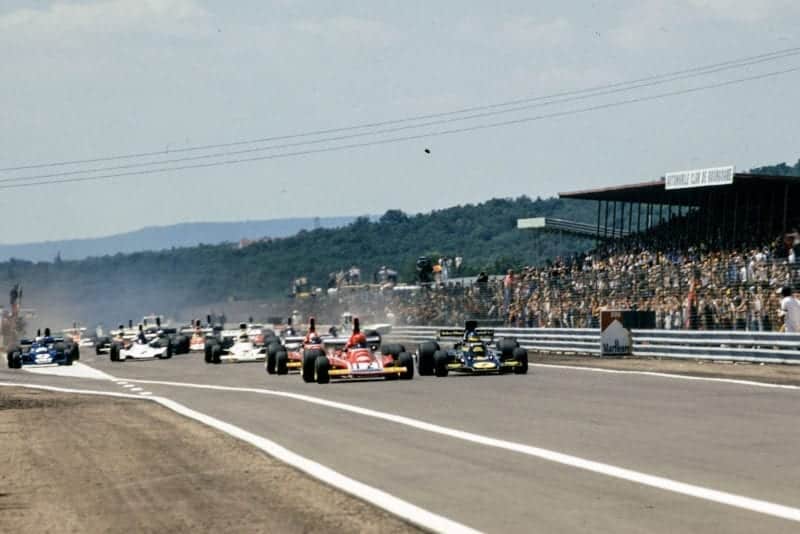
Lauda engages in an F1 drag race with Peterson
Motorsport Images
Sunday was bright and sunny and in the half-hour test session first thing in the morning Brambilla tried Stuck’s March, as his own was not repairable, and he went a lot quicker than the German had gone, so was all set to take his place on the grid with 741/1-2. The start was scheduled for mid-day, and before that there was a nostalgic parade of old Grand Prix cars driven by old Grand Prix drivers, and once they had all returned to their own paddock the Formula One cars went off on a warm-up lap and then lined up two-by-two on the dummy grid. All 22 cars moved forward to the starting grid and were kept there far too long, so that Pescarolo and Mass were beginning to have trouble holding their cars against the clutch. One or two engines were beginning to get a bit warm and Pryce was eyeing his temperature gauge anxiously when the starting signal was given, so got caught on the wrong foot and made a hesitant start. While Lauda and Peterson raced for the first corner there was a bit of a shambles behind them, for Reutemann’s Brabham,while dodging about in the pack, hit the side of Pryce’s Shadow which was deflected across the track right into the path of Hunt’s car, the Hesketh and the Shadow colliding for the second time in two races. The incident caused Jarier to virtually come to a stop and also Hulme was put off his stroke, so as the field covered the opening lap a lot of it was not in the order expected. Lauda beat Peterson to the first corner and was well ahead at the end of the opening lap, so that it looked as though it was all over as a race. However, Peterson had different ideas and had his sights firmly fixed on the fleeing Austrian, while Regazzoni was in third place, followed by Hailwood, Scheckter, Ickx, Fittipaldi, Depailler, Watson, Beltoise, Merzario, Brambilla, Hulme, Edwards, Hill and Jarier, Migault already being on his own at the back. Mass lasted only four laps before retiring with a burnt-out clutch, and after the dust had subsided a bit Pescarolo could be seen walking back to the pits having parked his BRM before the end of the first lap, also with a burnt-out clutch. Reutemann got round to the pits, after his starting line accident, and though the car was sorted out a bit, it was not right and he finally gave up after lapping at the tail of the field. Hunt and Pryce were out as a result of the starting line incident, so with the race barely started the field of 22 cars was reduced to 18. The two Ferraris, with the lone Lotus between them, were pulling away from the rest of the runners, and Hailwood was gradually elbowed back from fourth place to sixth place as his McLaren felt unsteady with its shock-absorbers not functioning properly.
Surprisingly, in view of the closeness of the practice times, the field soon separated into small groups and the expected jostling bunch in mid-field did not materialise. By 10 laps Lauda and Peterson had pulled away from Regazzoni, who in turn was well away from Scheckter and Fittipaldi; then came Hailwood, Ickx and Depailler, and a little while later Watson, Beltoise, Hulme, Merzario and Edwards, with Brambilla, Hill and Jarier bringing up the rear, Migault seemingly in another race altogether. Hulme was carefully picking his way through the slower cars at the back, taking a long while to get past Beltoise, While nearer the front Fittipaldi in the other Texaco-Marlboro McLaren was wishing he could find a way by Scheckter’s Tyrrell.
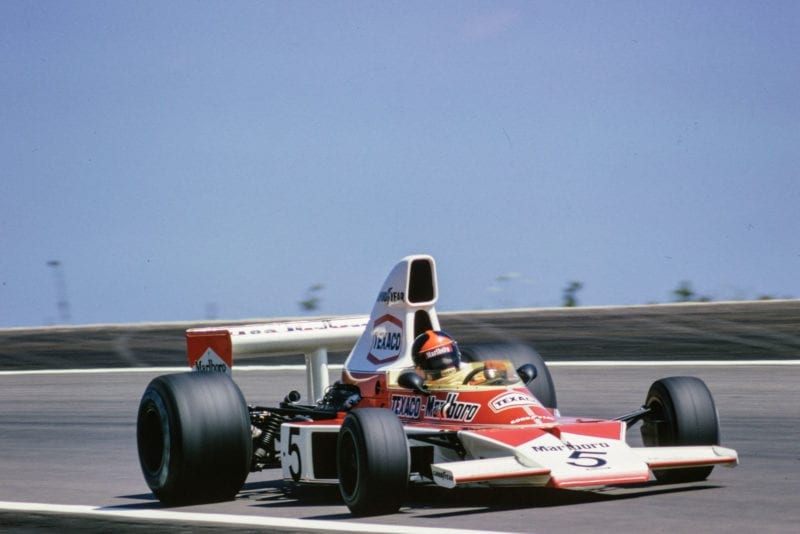
Title contender Fittpaldi retired on lap 27 with engine failure
Motorsport Images
At the front of the procession, Peterson was closing relentlessly on Lauda’s Ferrari and on lap 17 the Lotus swept by into the lead with no fuss or bother, and steadily pulled away. From then until the end of the 80 laps Peterson could do no wrong, the car running perfectly and handling perfectly, even as the fuel load diminished and the tyres wore, so that there was nothing that Lauda could do but try and keep the black and gold car in sight. His vain hope that something would break on the Lotus was of no avail, nor was the hope that Peterson would get baulked by a slower car when lapping the back-markers. The Swede went by the slower cars as if they were not there, and in fact, it was Lauda who got slightly delayed on occasions. Regazzoni was in a solid third place, but losing ground to the leader and his team-mate, and behind him Fittipaldi had got by Scheckter, in fourth place, the young Tyrrell driver hanging on to the Brazilian. Hulme was up into 9th place and was closing on Depailler and Watson’s efforts to stay ahead of Beltoise were confounded when his Cosworth engine went flat in its ignition department.
By half distance complete monotony had set in for Fittipaldi had dropped out with engine trouble, Watson had been forced to stop at the pits, and both Lolas had been in to change tyres that were giving trouble. Peterson was steadily lapping everyone, and Lauda was doing his best to follow him through the traffic. With Fittipaldi gone, Scheckter had resumed fourth place, and Hulme had got by Hailwood and Depailler and was firmly in sixth place behind a rather uninspired Ickx. Nothing changed before the end of the race, though Scheckter closed up on Regazzoni and made one or two half-hearted attempts to get by at the end of the main straight; at least Regazzoni considered them to be half-hearted, and he had no intention of moving over and giving third place to the Tyrrell.
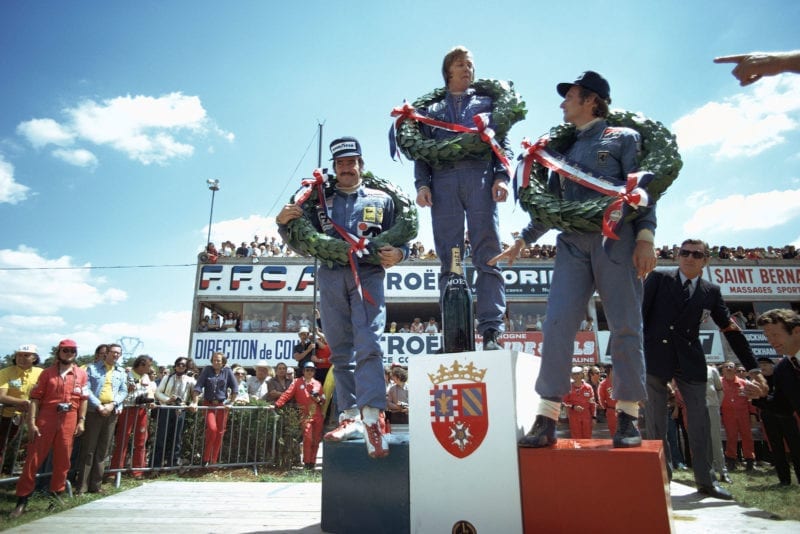
Peterson stands proudly on the top step
Motorsport Images
Once again Peterson restored the faith in Team Lotus, having driven in his usual hard and determined manner and as everyone wound down after the merry-go-round and realised it was all finished in just over 1 hr. 21 min., it was hard to believe the French Grand Prix had just taken place.—D.S.J.
***
Results (top five): Dijon-Prenois — 3.289 k./lap, 80 laps
1. R.Peterson – Lotus – I hr. 21 min. 55.02 sec. – 192.721 k.p.h.
2. N. Lauda – Ferrari – 1 hr. 22 min. 15.38 sec.
3. G. Regazzoni – Ferrari – 1 hr. 22 min. 22.86 sec.
4. J. Scheckter – Tyrrell – 1 hr. 22 min. 23.13 sec.
5. J.Ickx – Lotus – 1 hr. 22 min. 23.56 sec.
